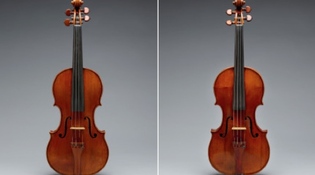 loading
loading
From the EditorMusical interludeHearing the differences in two priceless violins.  Yale School of MusicViolins by Amati (left) and Guarneri. View full image"I don’t know if I should tell you which instrument I’m playing,” said Ani Kavafian thoughtfully, violin in hand. Then, decisively: “Maybe I won’t!” And so the audience filling the second-floor room of the Yale Collection of Musical Instruments, some 100 of us, listened to Bach’s Violin Sonata in E Major without knowing which violin we were hearing. Was it the 1679 Nicolò Amati? Or the 1672 Andrea Guarneri? We had come to hear Kavafian demonstrate the difference between these two recent additions to the collection, yet we were in the dark. But my guess is that nobody cared. Kavafian was playing radiant Bach, every note alive and intense, and who could think about anything else? The Guarneris and Amatis were two of the celebrated families of instrument makers in Cremona, Italy, whose cutting-edge products were the disruptors of sixteenth- and seventeenth-century musical technology. Nicolò Amati (1596–1684), the greatest of the Amatis, may have trained Stradivarius. Andrea Guarneri (1626–1698), a student of Nicolò’s, was the patriarch of the family that produced Bartolomeo Giuseppe Guarneri (“del Gesù”)—Stradivarius’s great rival. The instruments bequeathed to Yale wouldn’t come close to fetching the astronomical prices of Strads, which are in the millions. But more importantly, being both in beautiful condition, these two violins preserve an iconic moment in European musical history. You might argue that they’re priceless. You would have particular success with that argument just after Ani Kavafian had played them. Kavafian, an eminent violinist who has performed with virtually every major orchestra and is a regular in the New York City chamber music scene, has taught at the Yale School of Music since 2006. She is short, with smooth black hair cut in a quasi-Egyptian shape, and she’s entirely dynamic and irrepressible (qualities that also inform her playing). After the Bach sonata, as she was discussing the two violins for us, she noticed a row of young people in the mostly gray-haired audience and stopped short, exclaiming, delighted, “All my students!” The violin she’d played for the Bach, Kavafian revealed, was the Guarneri; it “seemed to have the greater clarity” needed for Bach. The Amati, with “more of a throaty sound,” she pronounced “perfect for Debussy”; her second performance of the evening was his Sonata in G minor, which moves from haunting to thrillingly virtuosic. “You cannot imagine how different” the two violins “are from each other,” she told us. She’d had to learn quickly what each one liked and disliked—longer bow strokes or shorter, for instance. For Kavafian, whose own violin is “not too shabby—it’s a Strad,” the star of the evening may have been the bow she used. The man who left his instruments to Yale was Andrew Petryn ’43, head conservator of the University Art Gallery; he had been a violin prodigy and kept playing as an adult. So he collected not only violins, but also the bows to play them with—including the work of François Tourte (1747–1835), inventor of another great technological disruption, the modern bow. “Tourte is the Stradivarius of the bow makers,” said Kavafian, “and there are three in this collection. Three. To have one is incredible. When I showed this one to my bow repairer,” she added, holding it up, “he said, ‘Oh, my.’” The Amati, the Guarneri, and the three Tourtes are on view now in the Collection of Musical Instruments. Take a look when you’re in town. If you’re very lucky, maybe Ani Kavafian will drop by.
The comment period has expired.
|
|